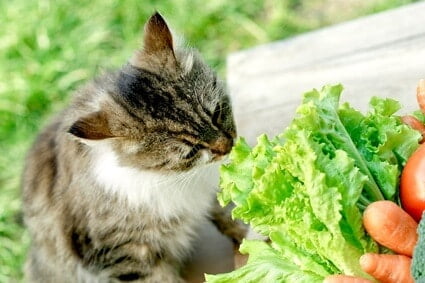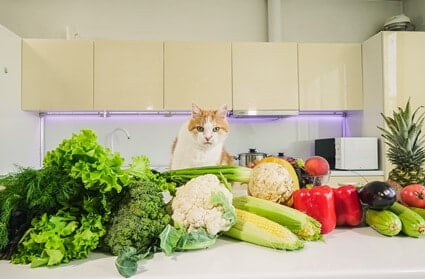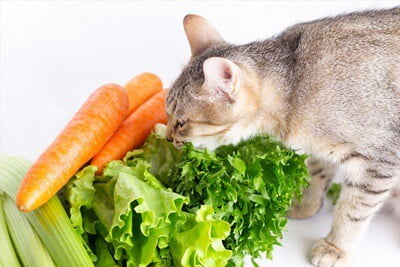As diet is a crucial factor in a feline’s wellbeing, many owners wonder if vegetables should be fed to a cat. There are several types of vegetables that cats can safely eat, but others should definitely be avoided.
Including vegetables, like pumpkin, squash, and peas, in a cat’s diet can be a good way to increase its nutritional intake. Pumpkin and squash can help maintain gastrointestinal health and movement. Peas, which are often included in pet food, are full of fiber. Cats cannot chew or process vegetable matter. This is why most vegetables need to be cooked before being fed to a cat as the cooking process begins breaking down the food.
There are vegetables that are toxic to cats, such as onions and garlic. Untreated, this can cause internal damage. Other vegetables, like potatoes and tomatoes, can make a cat unwell if the food is not prepared properly.
Are Vegetables Healthy for Cats?
A cat may not be that interested in eating vegetables. But, it can benefit from having small amounts of vegetables included in its diet.
You may already have noticed that many pet food companies list vegetables or vegetable extracts on the ingredients list. Given that cats are obligate carnivores, many owners might be confused, especially if they notice a cat chewing on the houseplants.
Cats derive a complete diet and all the nutrition they need from high-quality meat-based foods. Vegetables, though, can offer boosts in certain vitamins and minerals. Adding a small lift in nutrition. Due to the high water content of most vegetables, they can also assist with preventing dehydration.
It’s important to know that cats cannot process vegetable matter like omnivores or herbivores do. A cat will not benefit from eating vegetables as much as you would. Its digestive system will also struggle to break down raw vegetables efficiently. The digestive enzymes cats have are designed for breaking down meat, not plant matter.
Vegetables need to be prepared in a certain way to ensure that your cat won’t choke or suffer an internal impaction. Plus, cats only have four molar teeth. These teeth, too, are designed for cutting flesh or cutting bone, not grinding vegetable matter. Almost all vegetables must be cooked before being fed to a cat.
Can Cats Eat Broccoli?
Cooked broccoli florets are safe for cats to eat in small amounts. It can be a good way to discourage your cat from chewing on houseplants. Broccoli is a much better alternative for your cat. Broccoli is full of vitamins K and C, and potassium, fiber, and folate. Broccoli also offers:
- Warding off of free radicals
- Antioxidants
- A calming effect on an upset stomach
- Help with healthy bowel movements
Broccoli florets must be cooked thoroughly and cooled before being offered to your cat. Steaming the broccoli preserves the highest amount of nutrients and makes it safer for the cat to eat. Boiling is also a viable method of cooking. Remove the larger stems and cook until the broccoli is soft and tender.
Offer your cat the cooked and cooled broccoli in small pieces. Broccoli can be offered on its own as a treat or mixed in with the cat’s regular meal.

Can Cats Eat Carrot?
Cooked and diced carrots are safe for cats. Carrots are rich in vitamins and minerals, and are important for maintaining eye health. Including small amounts in your cat’s diet can be beneficial. Carrots can offer:
- Vitamin A
- Vitamin K
- Potassium
- Vitamin B6
- Fiber
Raw carrot should not be fed to your cat. Carrot should be thinly sliced and diced and cooked before being offered. After boiling or steaming the carrot, wait for it to cool before offering a small amount to your cat. Carrot can be offered on its own as a snack or mixed through regular meals on occasion.
Can Cats Eat Pumpkin?
Pumpkin isn’t only good for making the classic pumpkin pie! Small amounts of cooked pumpkin can help with constipation in cats. Vets may recommend including pumpkin in a cat’s diet if they regularly have constipation. Pumpkin also provides:
- Fiber, which helps cats on a diet feel fuller
- Vitamin A, which supports vision
- Vitamin C, which supports the immune system
- Zinc, which helps keep skin and fur healthy
Pumpkin must be served cooked and without seeds or rind. You can also use pre-cooked canned pumpkin so long as it does not contain any additives, sugars, or seasoning. Depending on how soft the pumpkin is, you can cut it into small pieces or mix a puree through your cat’s normal food.
Can Cats Eat Onion?
Cats cannot eat onions. This includes raw, cooked, and powdered forms. Feeding your cat onions will result in onion toxicities, which can be fatal if not treated immediately. A case study in Comparative Clinical Pathology discusses a case of onion toxicities in sheep. Of the flock, 2 animals died, 4 miscarried, and 12 more required medical treatment.
The oxidant found in onions reacts to a cat’s red blood cells and breaks them down. This is called hemolysis. Signs of onion toxicities include:
- Panting
- Weakness
- Vomiting
- Asthmatic attacks
- Diarrhea
- Lethargy
- Fainting
- Anemia
- Bloody urine
- Elevated heart rate
Do not feed your cat onions. Do not allow them to eat anything containing onions or onion powder. If your cat has eaten onion or food containing onion products contact a vet immediately.
Can Cats Eat Peas?
Peas are safe for cats to eat. Peas are actually used in recipes developed by a number of pet food companies. This is because peas are an excellent source of protein and fiber. Digestive systems benefit from peas, and this vegetable is good for maintaining healthy bowel movements. Peas also contain:
- Vitamin B1
- Vitamin C
- Vitamin K
- Iron
- Copper
- Potassium
- Magnesium
Cooked peas make a great low-calorie treat for cats, too. Occasionally feeding your cat peas can also have a positive impact on its gastrointestinal movements.
Peas should be cooked, cooled, and only offered whole to adult cats. Small or young cats risk choking on whole peas. Pureed peas can be added to these cats’ food. Be wary of feeding too many peas, however, as diarrhea can result from too much fiber.
Can Cats Eat Cucumber?
Cucumber is OK for cats to eat. It is also one of the few vegetables that can be provided raw. It is best to peel the skin or clean it thoroughly to remove any trace remains of pesticides.
Cucumber is high in vitamin K, which is fantastic for liver health and blood clotting. It is also high in water content, making it a good treat for keeping cats hydrated in hot weather. This vegetable is full of potassium, magnesium, copper, and molybdenum. This last item is a trace mineral that is good for a cat’s metabolism.
Cucumber should be cut into slices or strips and offered to your cat. Careful not to feed it too many, as this could result in diarrhea.
Can Cats Eat Asparagus?
Cats can eat asparagus. This vegetable, like broccoli, can prevent cats from chewing on houseplants. That is, if the cat is doing this due to an upset stomach that results in constipation or diarrhea.
Asparagus is highly fibrous. It should only be fed to cats fully cooked and in small portions. Feedings of asparagus should also happen no more than once or twice a week.
Feeding a cat too much asparagus can cause urinary problems. The high quantity of alkaline in asparagus can impact the cat’s internal pH levels, compromising its immune system. Specifically, the portions that maintain healthy bacteria levels in the bladder and urinary tract.
Can Cats Eat Squash?
Squash is nutritious, and your cat can safely eat it. Besides being a great source of vitamin A, squash contains:
- Vitamin C
- Vitamin B6
- Vitamin E
- Folate
- Pantothenic acid
- Thiamine
- Niacin
- Fiber
Adding small amounts of cooked squash to your cat’s diet can bring a lot of health benefits to the table. Squash can boost an immune system and help maintain a healthy heart and vascular health. Thiamine, in particular, enables the body to process carbohydrates as energy.
Squash must be cooked. Your cat’s digestive system will not be able to process vegetable matter easily. The process of cooking begins to break down the food, making it easier for the cat’s digestive system to process and extract nutrients from it.
Cooked squash is soft enough that dicing it into small cubes is fine. However, pureeing and mixing it through kibble or wet food is also a good option. Dribbling pureed squash over kibble is also a great way to introduce more water into a picky cat’s system.
Can Cats Eat Zucchini?
Zucchini is good for cats. It is especially good for obese cats that are on a vet-prescribed diet. Zucchini is both low on calories and high on vitamins, magnesium, iron, calcium, potassium, and dietary fiber.
Calcium is vital for a healthy cat, and not just for strong bones and teeth. Calcium is an electrolyte, and these regulate fluids and electronic pulses in the body. A cat low on dietary calcium may experience muscle twitches, stiffness, lethargy, and convulsions.
Zucchini is also high in water. Including zucchini in your cat’s diet can ensure that it is getting the proper amount of calcium. Zucchini needs to be cooked before it can be fed to your cat.
Can Cats Eat Tomatoes?
Debates about whether tomatoes are a fruit or a vegetable aside, cats can eat tomatoes. But, this does not mean a cat should be fed tomatoes.
Tomatoes are rich in vitamin C, potassium, and fiber. They are great to include in your own well-rounded diet. However, the same cannot be said for your cat. There are better foods to give to your cat that will offer these essential nutrients. Concerning tomatoes, the risks outweigh the benefits when it comes to your feline friend.
The tomato plant contains solanine, a natural pesticide. This is toxic to cats and will cause gastrointestinal issues. Every part of the tomato plant, including the vine, stem, and leaves, contains this substance. As do unripe tomatoes. Cooking doesn’t negate the compound either. Meaning that anything with tomato in it, like sauces and soups, can potentially be toxic.
If you caught your cat nibbling on a tomato, keep a close eye on it and contact a vet if any of the following symptoms appear:
- Diarrhea
- Dilated pupils
- Vomiting
- Loss of appetite
- Lethargy
- Disorientation
- Excessive drooling
It’s best to just avoid feeding your cat tomatoes. Don’t even let them lick up a ketchup spill.
Can Cats Eat Potatoes?
The potato family, when eaten raw, contains a substance called glycoalkaloid solanine. You’ll recognize this from the section above as the natural pesticide some plants produce.
Solanine is toxic to cats. This substance is the plant’s defense mechanism and can be found in the plant and the vegetable itself. Unripe potatoes, including the skin, are toxic to cats. Cooked potatoes, as they should only be cooked when ripe, are a different story.
Plain boiled, steamed, or baked potatoes can be fed to your cat as small and occasional additions to its regular meal. Fried or particularly oily potatoes will not do them any good, and can cause health problems as well.
Oddly, sweet potatoes do not contain solanine. If your cat steals a bite of mash from your plate it won’t hurt them. Including it as a semi-regular part of its diet, though, will cause digestive problems.
All and all, potatoes aren’t beneficial to a cat’s diet. It’s best to just avoid them all together.
Can Cats Eat Corn?
Corn isn’t harmful to cats. Nor does it offer them any nutritional benefits. It’s okay to offer your cat a few kernels of unseasoned, steamed corn.
Corn is often used as a filler ingredient in cheaper cat foods. This corn is usually cheap for a reason. Namely, if it’s low quality. If corn or corn meal is listed as an ingredient in cat food, it would be better to avoid that brand. Prolonged exposure to low quality food can negatively impact your cat’s development and health. It’s best to avoid including corn in a cat’s diet.
Can Cats Eat Lettuce?
Lettuce contains lots of dietary fiber. Introducing a small amount of finely chopped lettuce into your cat’s diet can help its digestive system. This is especially good for helping a constipated cat. Too much lettuce, though, and all that fiber will result in diarrhea.
Lettuce is also a source of vitamin A. Again, too much will cause vitamin A poisoning. However, there can be too much of a good thing.
Lettuce does not need to be cooked. It does need to be finely chopped up to prevent becoming a choking hazard though. Only a small amount of lettuce should be fed to your cat each week.
The most popular types of lettuce, including iceberg, leaf, and romaine, are all safe for cats.
Can Cats Eat Spinach?
Spinach is packed with vitamins and minerals. Spinach also happens to be safe for cats to eat, with one exception. Cats that experience urinary tract problems should not be fed spinach. This vegetable contains calcium oxalate, which can cause urinary crystals to develop.
Blanching and slicing up spinach can be a healthy way to boost your cat’s mineral and vitamin intake. It is important to do this infrequently to prevent calcium oxalate levels from growing too high.
Should the benefits of including spinach outweigh the risks, you should be aware of the signs of urinary crystals. The signs to watch for are:
- Bloody urine
- Painful, difficult, and/or frequent urination
- Passing urine outside of the litter box
- Spraying
- Excessive genital licking
Contact your vet and remove spinach from your cat’s diet immediately if any of these symptoms arise.
Can Cats Eat Garlic?
Garlic is toxic to cats, so it should never be fed to a cat. Garlic, like onions, is part of the allium family. Cats cannot process any of the foods in this group.
Beyond that, compounds in these foods actively damage cats internally. Eating just 1 clove of garlic is enough to cause hemolytic anemia and gastroenteritis. Untreated, garlic toxicities can lead to organ damage.

Why Are Vegetables In Cat Food?
Vegetables are included to ensure that your pet is getting all the nutrients it needs. Meat in cat food is cooked. During this process, it loses some of its nutritional value.
Vegetables are a low-calorie means of reintroducing those nutrients back into the meal. Vegetables also have additional minerals and vitamins that cannot be derived from meat. Or, at least in high quantities. While a cat may not need those minerals and vitamin levels to survive, it can benefit from them.
It’s also worth noting that wild cats do naturally consume small amounts of plant matter. A wild cat will devour the entirety of its prey, including the stomach and its contents. Additional nutrients, fibers, vitamins, and minerals can be obtained this way. Namely, because the prey animal has partially digested the food, making it possible for the cat’s system to finish the job. Domesticated cats don’t have the same option.
Can Cats Be Vegan or Vegetarian?
A cat cannot survive on a vegan or vegetarian diet. Adding small amounts of veg to its diet might be beneficial, but those foods cannot replace meat.
A cat will get the essential vitamins and minerals it needs from meat and only meat. Taurine is a key example. This is an amino-sulphonic acid that can only be obtained by eating meat. There is no substitute or supplement. As stated in Nutrition Research, cats with insufficient taurine can develop clinical health issues, such as a loss of eyesight, reproductive issues, abnormal development, and heart issues.
Cats can safely eat small amounts of some vegetables and grains. Cats cannot survive without a primarily meat-based diet.
Including certain vegetables in your cat’s diet can be beneficial to its health and wellbeing. Veg like cucumber, squash, peas, and pumpkin are full of vitamins and minerals. However, too much vegetable matter in a cat’s diet will do it more harm than good as cats cannot process vegetables.

